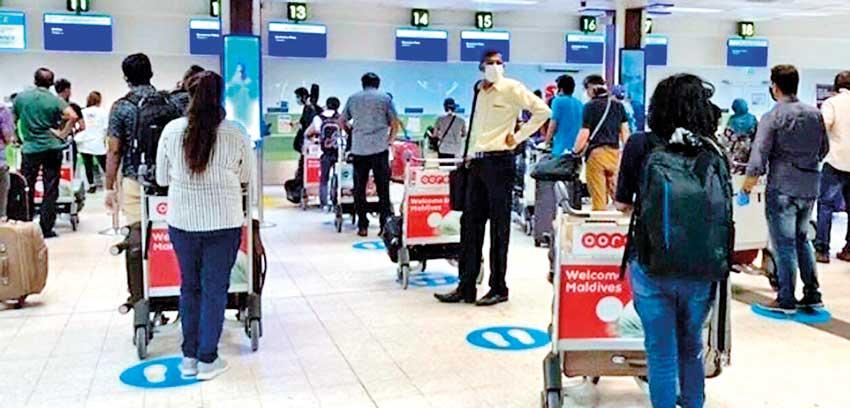20 May 2021 - {{hitsCtrl.values.hits}}

By Nishel Fernando
Sri Lanka’s outward labour migration declined sharply by 73.6 percent year-on-year (YoY) to 53,713 persons in 2020, with the spread of the COVID-19 pandemic worldwide.
“This sharp decline was attributable to the temporary ban imposed by the Sri Lanka Bureau of Foreign Employment (SLBFE) on departures of migrant workers registered with it, travel restrictions at labour receiving countries, suspension of recruitment of foreign workers and reduced demand for migrant labour,” the Central Bank stated in its recently released annual report.
Both male and female departures for foreign employment declined by 73.5 percent and 73.7 percent, respectively in 2020, compared to 2019, when the country recorded 203,087 labour departures.
The Middle East region maintained its position as the main foreign employment destination in 2020 as well, accounting for 82 percent of the total departures for foreign employment. However, the departures for foreign employment to the region declined by 74.5 percent YoY.
According to the Central Bank, 34.1 percent of labour migrations took place through the country’s foreign employment agencies during the year.
The composition of labour migrations remained largely unchanged in 2020, with 28.6 percent of the people departing the country to take housemaid jobs in particular in the Middle Eastern countries.
However, skilled labours accounted for 31.1 percent of the migrations in the year while unskilled labour segment accounted for 26.1 percent, followed by professionals accounting for 5.5 percent.
The figures were consistent with the estimates of the Association of Licensed Foreign Employment Agencies (ALFEA).
The ALFEA noted that the majority of outward labour migrations took place early last year, before the first wave of the pandemic.
As per the available data, 40,000 Sri Lankan migrant workers have been repatriated to the country amid job losses and contract expiration in the first half of 2020.
With the domestic labour market is already in a turmoil from the negative impacts of COVID-19, the Central Bank stressed that appropriate measures must be introduced to facilitate the reemployment of migrant workers, who were repatriated due to job losses as well as persons who missed the anticipated foreign employment opportunities.
Sri Lanka’s unemployment rate moderated to 5.2 percent in the fourth quarter of last year, after reaching a record high of 5.8 percent in the third quarter of the same year.
However, the labour force participation rate declined to 50.1 percent in the fourth quarter of last year, from 51 percent in the previous quarter and 51.9 percent a year ago, indicating contraction in the labour force.
Although the ALFEA was expecting a recovery in the outward labour migration entering this year, the current environment remains extremely challenging, given that several key host countries of labour have imposed travel restrictions on Sri Lankans, due to the on-going COVID-19 third wave in Sri Lanka.
The Central Bank highlighted the need for appropriate social security measures to face future distresses in the international labour market.
However, the impacts of the sharp decline in outward labour migration are yet to be materialised in the official workers’ remittance inflows to the country.
Despite the decline in outward labour migrations, the official workers’ remittance inflows have been increasing from May last year onwards, to record high levels, defying the earlier gloomy predictions. A similar trend was also observed in countries such as Bangladesh and Pakistan as well.
Analysts opined that this trend was partly due to the diversion from informal remittance channels towards more formal channels, due to the disruptions caused by the coronavirus.
The Institute of Policy Studies (IPS) noted that Sri Lankans abroad in western countries, who are less affected by the pandemic, might have contributed to this increase as well. Further, it added that the Central Bank’s Special Deposit Accounts (SDA) have also lured in new remitters, due to attractive rates.
Encouraged by the current trend, the Central Bank expects a record US $ 8 billion inflows from workers’ remittances this year, compared to US $ 7.1 billion inflows in 2020.
24 Nov 2024 2 hours ago
24 Nov 2024 3 hours ago
24 Nov 2024 3 hours ago
24 Nov 2024 5 hours ago